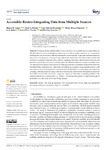Mostrar o rexistro simple do ítem
Accessible Routes Integrating Data from Multiple Sources
| dc.contributor.author | Rodríguez Luaces, Miguel | |
| dc.contributor.author | Arias Fisteus, Jesús | |
| dc.contributor.author | Sánchez-Fernández, Luis | |
| dc.contributor.author | Muñoz-Organero, Mario | |
| dc.contributor.author | Balado, Jesús | |
| dc.contributor.author | Díaz-Vilariño, Lucía | |
| dc.contributor.author | Lorenzo, Henrique | |
| dc.date.accessioned | 2021-03-17T16:38:35Z | |
| dc.date.available | 2021-03-17T16:38:35Z | |
| dc.date.issued | 2020-12-26 | |
| dc.identifier.citation | Luaces, M.R.; Fisteus, J.A.; Sánchez-Fernández, L.; Munoz-Organero, M.; Balado, J.; Díaz-Vilariño, L.; Lorenzo, H. Accessible Routes Integrating Data from Multiple Sources. ISPRS Int. J. Geo-Inf. 2021, 10, 7. https://doi.org/10.3390/ijgi10010007 | es_ES |
| dc.identifier.issn | 2220-9964 | |
| dc.identifier.uri | http://hdl.handle.net/2183/27553 | |
| dc.description.abstract | [Abstract] Providing citizens with the ability to move around in an accessible way is a requirement for all cities today. However, modeling city infrastructures so that accessible routes can be computed is a challenge because it involves collecting information from multiple, large-scale and heterogeneous data sources. In this paper, we propose and validate the architecture of an information system that creates an accessibility data model for cities by ingesting data from different types of sources and provides an application that can be used by people with different abilities to compute accessible routes. The article describes the processes that allow building a network of pedestrian infrastructures from the OpenStreetMap information (i.e., sidewalks and pedestrian crossings), improving the network with information extracted obtained from mobile-sensed LiDAR data (i.e., ramps, steps, and pedestrian crossings), detecting obstacles using volunteered information collected from the hardware sensors of the mobile devices of the citizens (i.e., ramps and steps), and detecting accessibility problems with software sensors in social networks (i.e., Twitter). The information system is validated through its application in a case study in the city of Vigo (Spain). | es_ES |
| dc.description.sponsorship | This work was supported in part by the project Friendly barrierLess AdapTable City (FLATCity) (Ministerio de Ciencia, innovación y Universidades/ERDF, EU) funded by the Spanish Agencia Estatal de Investigación (AEI, doi 10.13039/501100011033), and in part by the European Regional Development Fund (ERDF), under Grants TIN2016-77158-C4-1-R, TIN2016-77158-C4-2-R and TIN2016-77158-C4-3-R. This work was also supported in part by the project Massive Geospatial Data Storage and Processing for Intelligent and Sustainable Urban Transportation (MaGIST), funded by the Spanish Agencia Estatal de Investigación (AEI, doi 10.13039/501100011033) under grants PID2019-105221RB-C41, PID2019-105221RB-C43 and PID2019-105221RB-C44. The research of Miguel R. Luaces was also partially founded by: Xunta de Galicia/FEDER-UE GRC: ED431C 2017/58 and Xunta de Galicia/FEDER-UE, ConectaPeme, GEMA: IN852A 2018/14. Miguel R. Luaces also wishes to acknowledge the support received from the Centro de Investigación de Galicia “CITIC”, funded by Xunta de Galicia and the European Union (European Regional Development Fund- Galicia 2014-2020 Program), by grant ED431G 2019/01. Jesús Balado and Lucía Díaz-Vilariño would like to thank to the Xunta de Galicia given through human resources grants ED481B-2019-061 and ED481D 2019/020, respectively | es_ES |
| dc.description.sponsorship | Xunta de Galicia; ED431C 2017/58 | es_ES |
| dc.description.sponsorship | Xunta de Galicia; IN852A 2018/14 | es_ES |
| dc.description.sponsorship | Xunta de Galicia; ED481B-2019-061 | es_ES |
| dc.description.sponsorship | Xunta de Galicia; ED481D2019/020 | es_ES |
| dc.description.sponsorship | Xunta de Galicia; ED431G 2019/01 | es_ES |
| dc.language.iso | eng | es_ES |
| dc.publisher | MDPI AG | es_ES |
| dc.relation.uri | https://doi.org/10.3390/ijgi10010007 | es_ES |
| dc.rights | Atribución 4.0 Internacional | es_ES |
| dc.rights.uri | http://creativecommons.org/licenses/by/4.0/ | * |
| dc.subject | Spatial data mining | es_ES |
| dc.subject | Geospatial NLP | es_ES |
| dc.subject | Geospatial data fusion | es_ES |
| dc.subject | Large scale geospatial processing | es_ES |
| dc.subject | Pedestrian navigation | es_ES |
| dc.subject | Physical accessibility | es_ES |
| dc.title | Accessible Routes Integrating Data from Multiple Sources | es_ES |
| dc.type | journal article | es_ES |
| dc.rights.accessRights | open access | es_ES |
| UDC.journalTitle | ISPRS International Journal of Geo-Information | es_ES |
| UDC.volume | 10 | es_ES |
| UDC.issue | 1 | es_ES |
| UDC.startPage | 7 | es_ES |
| dc.identifier.doi | 10.3390/ijgi10010007 | |
| UDC.coleccion | Investigación | es_ES |
| UDC.departamento | Ciencias da Computación e Tecnoloxías da Información | es_ES |
| UDC.grupoInv | Laboratorio de Bases de Datos (LBD) | es_ES |
| dc.relation.projectID | info:eu-repo/grantAgreement/AEI/Plan Estatal de Investigación Científica y Técnica y de Innovación 2013-2016/TIN2016-77158-C4-1-R/ES/ANALYTICS USING SENSOR DATA FOR FLATCITY | |
| dc.relation.projectID | info:eu-repo/grantAgreement/AEI/Plan Estatal de Investigación Científica y Técnica y de Innovación 2013-2016/TIN2016-77158-C4-2-R/ES/3D ROUTE MODELING FOR FLATCITY | |
| dc.relation.projectID | info:eu-repo/grantAgreement/AEI/Plan Estatal de Investigación Científica y Técnica y de Innovación 2013-2016/TIN2016-77158-C4-3-R/ES/VELOCITY: PROCESADO EFICIENTE DE BIG DATA ESPACIO-TEMPORAL PARA FLATCITY | |
| dc.relation.projectID | info:eu-repo/grantAgreement/AEI/Plan Estatal de Investigación Científica y Técnica y de Innovación 2017-2020/PID2019-105221RB-C41/ES/VISUALIZACION Y EXPLORACION BASADA EN FLUJOS Y ANALITICA DE BIG DATA ESPACIAL | |
| dc.relation.projectID | info:eu-repo/grantAgreement/AEI/Plan Estatal de Investigación Científica y Técnica y de Innovación 2017-2020/PID2019-105221RB-C43/ES/INTELIGENCIA GEOESPACIAL COMO SOPORTE A LA TOMA DE DECISIONES EN MOVILIDAD URBANA | |
| dc.relation.projectID | info:eu-repo/grantAgreement/AEI/Plan Estatal de Investigación Científica y Técnica y de Innovación 2017-2020/PID2019-105221RB-C44/ES/ANALISIS EN TIEMPO REAL DE SENSORES SOCIALES Y ESTIMACION DE RECURSOS PARA TRANSPORTE MULTIMODAL BASADA EN APRENDIZAJE PROFUNDO |
Ficheiros no ítem
Este ítem aparece na(s) seguinte(s) colección(s)
-
Investigación (FIC) [1654]






